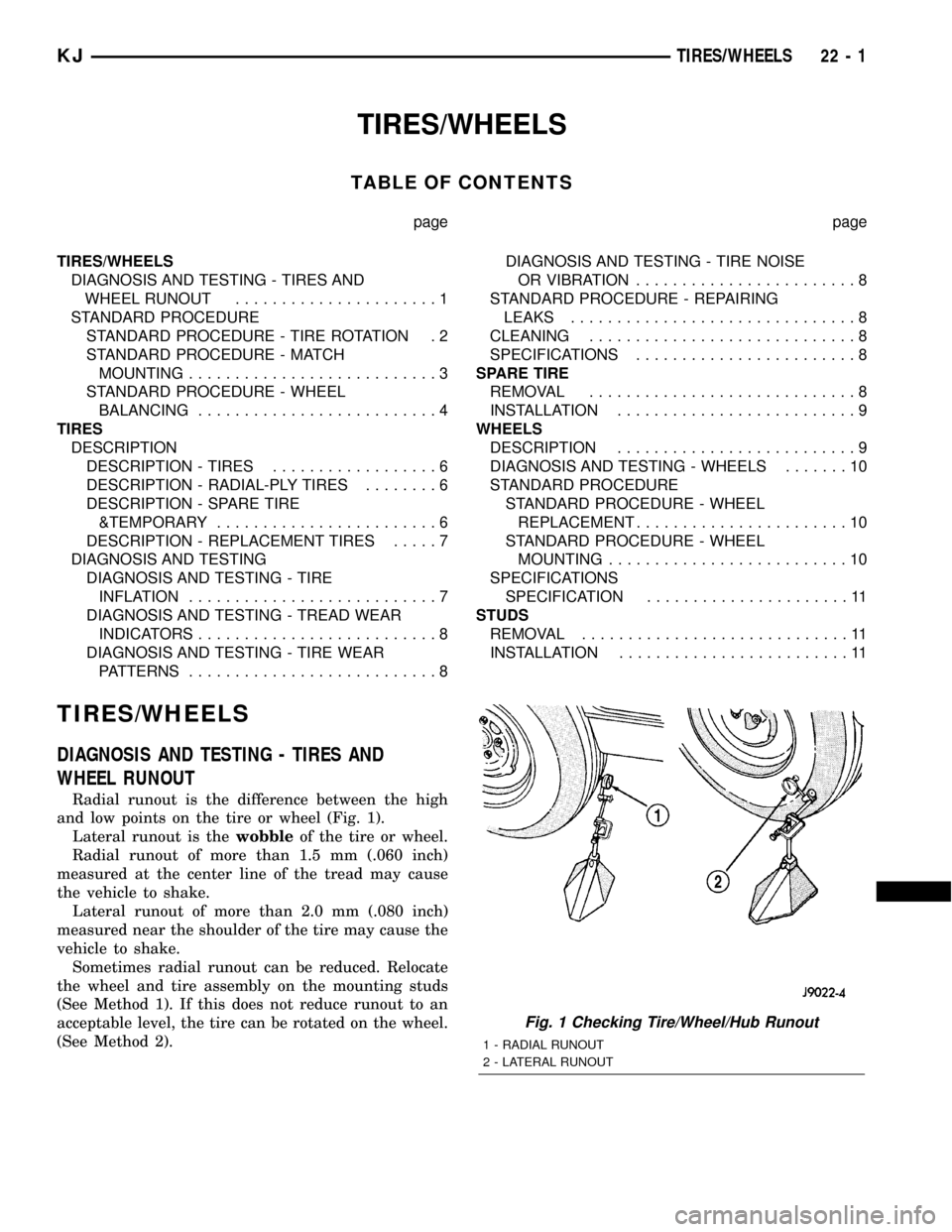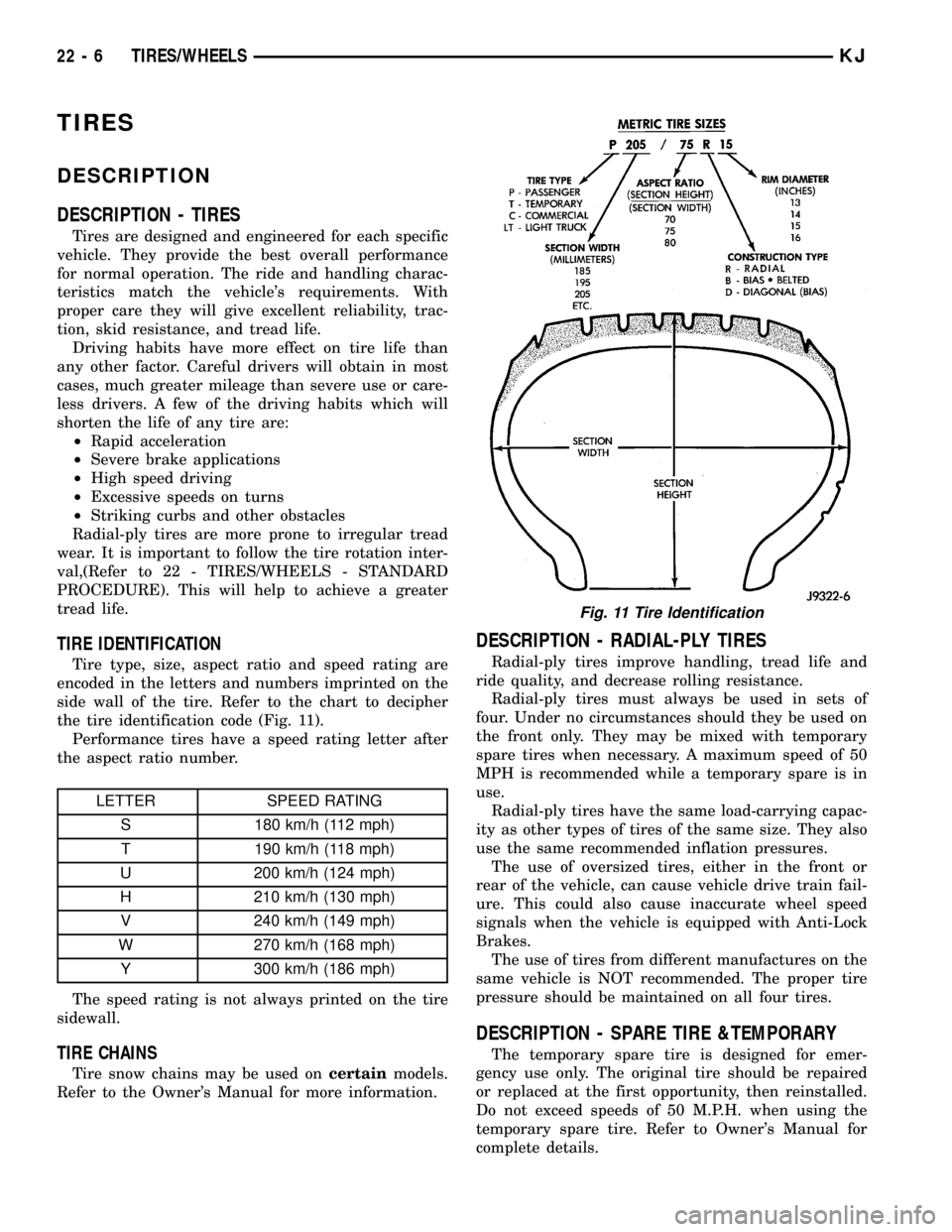spare tire JEEP LIBERTY 2002 KJ / 1.G Workshop Manual
[x] Cancel search | Manufacturer: JEEP, Model Year: 2002, Model line: LIBERTY, Model: JEEP LIBERTY 2002 KJ / 1.GPages: 1803, PDF Size: 62.3 MB
Page 445 of 1803

front of the vehicle. In certain markets where
required, a headlamp leveling actuator motor is
included on each headlamp.
²Park Lamps- The park lamps include the front
park lamps and front side marker lamps that are
integral to the front lamp units mounted at each end
of the bumper fascia at the front of the vehicle, as
well as the rear park lamps and rear side marker
lamps that are integral to the rear lamp units
mounted to the back of the quarter panel on each
side of the tailgate at the rear of the vehicle. The
park lamps include a license plate lamp or lamps,
depending upon the requirements of the market for
which the vehicle is manufactured. Vehicles with a
license plate tub located near the left end of the rear
bumper fascia have a single lamp, while vehicles
with a license plate module located on the spare tire
carrier have two license plate lamps. In certain mar-
kets where required, a front position lamp that is
integral to each headlamp unit is illuminated instead
of the front park lamps and front side marker lamps
in the park lamps circuit; and, a rectangular, red
reflector is located on the rear bumper fascia just
inboard and below each rear lamp unit.
²Rear Fog Lamps- Rear fog lamps are avail-
able only in certain markets where they are required
equipment. The rear fog lamps are integral to the
rear lamp units mounted to the back of the quarter
panel on each side of the tailgate at the rear of the
vehicle.
²Turn Signal Lamps- The turn signal lamps
include the front turn signal and front side marker
lamps that are integral to the front lamp units
mounted at each end of the bumper fascia at the
front of the vehicle, as well as rear turn signal lamps
that are integral to the rear lamp units mounted to
the back of the quarter panel on each side of the tail-
gate at the rear of the vehicle. In certain markets
where required, a repeater lamp unit mounted to
each front fender just behind the front wheel opening
is illuminated instead of the front side marker lamp
in each turn signal lamp circuit.
Other components of the exterior lighting system
for this model include:
²Combination Flasher- An electronic combina-
tion flasher is integral to the hazard warning switch
in the center of the instrument panel.
²Backup Lamp Switch- Vehicles equipped with
a manual transmission have a plunger-type backup
lamp switch located on the transmission housing. ATransmission Range Sensor (TRS) integral to the
solenoid pack on the valve body of the optional elec-
tronic automatic transmission performs the backup
lamp switch function on models that are so equipped.
²Brake Lamp Switch- A plunger-type brake
lamp switch is located on the steering column sup-
port bracket under the instrument panel and actu-
ated by the brake pedal arm.
²Body Control Module- The Body Control
Module (BCM) is located on the Junction Block (JB)
under the driver side outboard end of the instrument
panel. (Refer to 8 - ELECTRICAL/ELECTRONIC
CONTROL MODULES/BODY CONTROL MODULE
- DESCRIPTION).
²Daytime Running Lamp Relay- Vehicles
manufactured for sale in Canada use a solid state
Daytime Running Lamps (DRL) relay installed in the
Junction Block (JB) instead of the conventional high
beam relay.
²Front Fog Lamp Relay- Vehicles equipped
with the optional front fog lamps have a front fog
lamp relay located in the Junction Block (JB).
²Hazard Switch- The hazard switch is located
near the center of the instrument panel and includes
the integral electronic combination flasher circuitry
for the hazard warning system and the turn signal
system.
²Headlamp Leveling Motor- A headlamp lev-
eling actuator motor is located on the back of each
headlamp housing of vehicles manufactured for cer-
tain markets where this equipment is required.
²Headlamp Leveling Switch- A thumbwheel
actuated headlamp leveling switch is mounted in the
driver side inboard instrument panel trim bezel of
vehicles manufactured for certain markets where this
equipment is required.
²High Beam Relay- A high beam relay is
located in the Junction Block (JB) of all vehicles
except those that are manufactured for sale in Can-
ada. Canadian vehicles have a solid state Daytime
Running Lamps (DRL) relay in the JB instead of the
high beam relay.
²Low Beam Relay- A low beam relay is located
in the Junction Block (JB) of all vehicles.
²Multi-Function Switch- The multi-function
switch is located on the top of the steering column,
just below the steering wheel. The multi-function
switch includes a left (lighting) control stalk and a
right (wiper) control stalk. The left control stalk is
dedicated to providing almost all of the driver con-
1 - HEADLAMP UNIT (2)
2 - REPEATER LAMP UNIT (2)
3 - FRONT POSITION LAMP (2)
4 - FRONT LAMP UNIT (2)
5 - FRONT FOG LAMP (2)6 - CENTER HIGH MOUNTED STOP LAMP UNIT
7 - REAR LAMP UNIT
8 - LICENSE PLATE LAMP UNIT
8L - 4 LAMPS/LIGHTING - EXTERIORKJ
LAMPS/LIGHTING - EXTERIOR (Continued)
Page 485 of 1803

(3) Turn the adjusting screw (Fig. 44) until the top
edge of the beam intensity pattern is positioned from
just below horizontal to 75 millimeters (3 inches)
below the headlamp horizontal centerline for vehicles
in North America, or from just below horizontal to
125 millimeters (5 inches) below the headlamp hori-
zontal centerline for vehicles in Rest-Of-World.
(4) Repeat the adjustment procedure for the oppo-
site headlamp.
LICENSE PLATE LAMP BULB
REMOVAL
NORTH AMERICA
(1) Disconnect and isolate the battery negative
cable.
(2) Reach through the opening in the rear bumper
fascia between the license plate and the lamp to
access and firmly grasp the socket on the back of the
license plate lamp unit housing (Fig. 45).
(3) Pull the socket and bulb straight out of the
back of the license plate lamp unit housing.
(4) Pull the bulb straight out of the license plate
lamp unit socket.
REST-OF-WORLD
(1) Disconnect and isolate the battery negative
cable.
(2) Unsnap and lift up the bottom of the license
mounting plate far enough to access and remove the
two screws that secure the license plate bracket to
the special lug nuts on the spare tire (Fig. 46).(3) Swing the license plate bracket away from the
spare tire far enough to access the license plate lamp
bulb sockets.
(4) Firmly grasp the socket on the top of the
license plate lamp unit housing for the bulb that is
being removed (Fig. 47).
(5) Rotate the socket on the top of the license plate
lamp unit housing counterclockwise about 30
degrees.
(6) Pull the socket and bulb straight out of the top
of the license plate lamp unit housing.
Fig. 44 Headlamp Adjusting Screw
1 - HEADLAMP UNIT
2 - FENDER PANEL
3 - ADJUSTING SCREW ACCESS HOLE
4 - UPPER RADIATOR CROSSMEMBER
Fig. 45 License Plate Lamp Bulb Remove/Install -
North America
1 - REAR BUMPER FASCIA
2 - LICENSE PLATE LAMP
3 - SOCKET
4 - BULB
Fig. 46 License Plate Bracket - Rest-Of-World
1 - SPARE TIRE
2 - SPECIAL LUG NUT (2)
3 - LICENSE PLATE BRACKET
4 - SCREW (2)
8L - 44 LAMPS/LIGHTING - EXTERIORKJ
HEADLAMP UNIT (Continued)
Page 486 of 1803

(7) Pull the bulb straight out of the license plate
lamp unit socket.
INSTALLATION
CAUTION: Always use the correct bulb size and
type for replacement. An incorrect bulb size or type
may overheat and cause damage to the lamp, the
socket and/or the lamp wiring.
NORTH AMERICA
(1) Align the base of the bulb with the receptacle
in the license plate lamp unit socket.
(2) Push the bulb straight into the license plate
lamp unit socket until it is firmly seated.
(3) Reach through the opening in the rear bumper
fascia between the license plate and the lamp to
align the socket and bulb with the socket opening on
the back of the lamp unit housing (Fig. 45).
(4) Push the socket and bulb straight into the
license plate lamp unit housing until it is firmly
seated.
(5) Reconnect the battery negative cable.
REST-OF-WORLD
(1) Align the base of the bulb with the receptacle
in the license plate lamp unit socket.
(2) Push the bulb straight into the license plate
lamp unit socket until it is firmly seated.
(3) Align the socket and bulb with the socket open-
ing on the top of the license plate lamp unit housing
(Fig. 47).(4) Push the socket and bulb straight into the
license plate lamp unit housing until it is firmly
seated.
(5) Rotate the socket on the top of the license plate
lamp unit housing clockwise about 30 degrees.
(6) Swing the license plate bracket back against
the spare tire (Fig. 46).
(7) Lift up the bottom of the license mounting
plate far enough to install and tighten the two
screws that secure the license plate bracket to the
special lug nuts on the spare tire. Tighten the screws
to 28 N´m (21 ft. lbs.).
(8) Lower the bottom of the license mounting plate
and, using hand pressure, snap it into place on the
license plate bracket.
(9) Reconnect the battery negative cable.
LICENSE PLATE LAMP UNIT
REMOVAL
NORTH AMERICA
(1) Disconnect and isolate the battery negative
cable.
(2) Remove the two screws that secure the license
plate lamp unit to the rear bumper fascia (Fig. 48).
(3) Pull the license plate lamp unit down and out
through the mounting hole in the rear bumper fascia
far enough to access and disconnect the wire harness
connector for the lamp socket pigtail wire.
(4) Remove the license plate lamp unit from the
rear bumper fascia.
Fig. 47 License Plate Lamp Bulb Remove/Install -
Rest-Of-World
1 - LAMP UNIT (2)
2 - LICENSE PLATE BRACKET
3 - SCREW (4)
4 - BULB & SOCKET (2)
Fig. 48 License Plate Lamp Unit Remove/Install
1 - REAR BUMPER FASCIA
2 - LICENSE PLATE LAMP UNIT
3 - SCREW (2)
KJLAMPS/LIGHTING - EXTERIOR 8L - 45
LICENSE PLATE LAMP BULB (Continued)
Page 529 of 1803

mounted to the back of the quarter panel on each
side of the tailgate at the rear of the vehicle. The
park lamps include a license plate lamp or lamps,
depending upon the requirements of the market for
which the vehicle is manufactured. Vehicles with a
license plate tub located near the left end of the rear
bumper fascia have a single lamp, while vehicles
with a license plate module located on the spare tire
carrier have two license plate lamps. In certain mar-
kets where required, a front position lamp that is
integral to each headlamp unit is illuminated instead
of the front park lamps and front side marker lamps
in the park lamps circuit; and, a rectangular, red
reflector is located on the rear bumper fascia just
inboard and below each rear lamp unit.
²Rear Fog Lamps- Rear fog lamps are avail-
able only in certain markets where they are required
equipment. The rear fog lamps are integral to the
rear lamp units mounted to the back of the quarter
panel on each side of the tailgate at the rear of the
vehicle.
²Turn Signal Lamps- The turn signal lamps
include the front turn signal and front side marker
lamps that are integral to the front lamp units
mounted at each end of the bumper fascia at the
front of the vehicle, as well as rear turn signal lamps
that are integral to the rear lamp units mounted to
the back of the quarter panel on each side of the tail-
gate at the rear of the vehicle. In certain markets
where required, a repeater lamp unit mounted to
each front fender just behind the front wheel opening
is illuminated instead of the front side marker lamp
in each turn signal lamp circuit.
Other components of the exterior lighting system
for this model include:
²Combination Flasher- An electronic combina-
tion flasher is integral to the hazard warning switch
in the center of the instrument panel.
²Backup Lamp Switch- Vehicles equipped with
a manual transmission have a plunger-type backup
lamp switch located on the transmission housing. A
Transmission Range Sensor (TRS) integral to the
solenoid pack on the valve body of the optional elec-
tronic automatic transmission performs the backup
lamp switch function on models that are so equipped.
²Brake Lamp Switch- A plunger-type brake
lamp switch is located on the steering column sup-
port bracket under the instrument panel and actu-
ated by the brake pedal arm.²Body Control Module- The Body Control
Module (BCM) is located on the Junction Block (JB)
under the driver side outboard end of the instrument
panel. (Refer to 8 - ELECTRICAL/ELECTRONIC
CONTROL MODULES/BODY CONTROL MODULE
- DESCRIPTION).
²Daytime Running Lamp Relay- Vehicles
manufactured for sale in Canada use a solid state
Daytime Running Lamps (DRL) relay installed in the
Junction Block (JB) instead of the conventional high
beam relay.
²Front Fog Lamp Relay- Vehicles equipped
with the optional front fog lamps have a front fog
lamp relay located in the Junction Block (JB).
²Hazard Switch- The hazard switch is located
near the center of the instrument panel and includes
the integral electronic combination flasher circuitry
for the hazard warning system and the turn signal
system.
²Headlamp Leveling Motor- A headlamp lev-
eling actuator motor is located on the back of each
headlamp housing of vehicles manufactured for cer-
tain markets where this equipment is required.
²Headlamp Leveling Switch- A thumbwheel
actuated headlamp leveling switch is mounted in the
driver side inboard instrument panel trim bezel of
vehicles manufactured for certain markets where this
equipment is required.
²High Beam Relay- A high beam relay is
located in the Junction Block (JB) of all vehicles
except those that are manufactured for sale in Can-
ada. Canadian vehicles have a solid state Daytime
Running Lamps (DRL) relay in the JB instead of the
high beam relay.
²Low Beam Relay- A low beam relay is located
in the Junction Block (JB) of all vehicles.
²Multi-Function Switch- The multi-function
switch is located on the top of the steering column,
just below the steering wheel. The multi-function
switch includes a left (lighting) control stalk and a
right (wiper) control stalk. The left control stalk is
dedicated to providing almost all of the driver con-
trols for both the exterior and interior lighting sys-
tems.
²Park Lamp Relay- A park lamp relay is
located in the Junction Block (JB) of all vehicles.
²Rear Fog Lamp Relay- Vehicles manufac-
tured for certain markets where rear fog lamps are
required equipment have a rear fog lamp relay
located in the Junction Block (JB).
1 - HEADLAMP UNIT (2)
2 - REPEATER LAMP UNIT (2)
3 - FRONT POSITION LAMP (2)
4 - FRONT LAMP UNIT (2)5 - FRONT FOG LAMP (2)
6 - CENTER HIGH MOUNTED STOP LAMP UNIT
7 - REAR LAMP UNIT
8 - LICENSE PLATE LAMP UNIT
8Ls - 4 LAMPSKJ
LAMPS/LIGHTING - EXTERIOR (Continued)
Page 569 of 1803

below the headlamp horizontal centerline for vehicles
in North America, or from just below horizontal to
125 millimeters (5 inches) below the headlamp hori-
zontal centerline for vehicles in Rest-Of-World.
(4) Repeat the adjustment procedure for the oppo-
site headlamp.
LICENSE PLATE LAMP BULB
REMOVAL
NORTH AMERICA
(1) Disconnect and isolate the battery negative
cable.
(2) Reach through the opening in the rear bumper
fascia between the license plate and the lamp to
access and firmly grasp the socket on the back of the
license plate lamp unit housing (Fig. 45).
(3) Pull the socket and bulb straight out of the
back of the license plate lamp unit housing.
(4) Pull the bulb straight out of the license plate
lamp unit socket.
REST-OF-WORLD
(1) Disconnect and isolate the battery negative
cable.
(2) Unsnap and lift up the bottom of the license
mounting plate far enough to access and remove the
two screws that secure the license plate bracket to
the special lug nuts on the spare tire (Fig. 46).
(3) Swing the license plate bracket away from the
spare tire far enough to access the license plate lamp
bulb sockets.(4) Firmly grasp the socket on the top of the
license plate lamp unit housing for the bulb that is
being removed (Fig. 47).
(5) Rotate the socket on the top of the license plate
lamp unit housing counterclockwise about 30
degrees.
(6) Pull the socket and bulb straight out of the top
of the license plate lamp unit housing.
(7) Pull the bulb straight out of the license plate
lamp unit socket.
Fig. 44 Headlamp Adjusting Screw
1 - HEADLAMP UNIT
2 - FENDER PANEL
3 - ADJUSTING SCREW ACCESS HOLE
4 - UPPER RADIATOR CROSSMEMBER
Fig. 45 License Plate Lamp Bulb Remove/Install -
North America
1 - REAR BUMPER FASCIA
2 - LICENSE PLATE LAMP
3 - SOCKET
4 - BULB
Fig. 46 License Plate Bracket - Rest-Of-World
1 - SPARE TIRE
2 - SPECIAL LUG NUT (2)
3 - LICENSE PLATE BRACKET
4 - SCREW (2)
8Ls - 44 LAMPSKJ
HEADLAMP UNIT (Continued)
Page 570 of 1803

INSTALLATION
CAUTION: Always use the correct bulb size and
type for replacement. An incorrect bulb size or type
may overheat and cause damage to the lamp, the
socket and/or the lamp wiring.
NORTH AMERICA
(1) Align the base of the bulb with the receptacle
in the license plate lamp unit socket.
(2) Push the bulb straight into the license plate
lamp unit socket until it is firmly seated.
(3) Reach through the opening in the rear bumper
fascia between the license plate and the lamp to
align the socket and bulb with the socket opening on
the back of the lamp unit housing (Fig. 45).
(4) Push the socket and bulb straight into the
license plate lamp unit housing until it is firmly
seated.
(5) Reconnect the battery negative cable.
REST-OF-WORLD
(1) Align the base of the bulb with the receptacle
in the license plate lamp unit socket.
(2) Push the bulb straight into the license plate
lamp unit socket until it is firmly seated.
(3) Align the socket and bulb with the socket open-
ing on the top of the license plate lamp unit housing
(Fig. 47).
(4) Push the socket and bulb straight into the
license plate lamp unit housing until it is firmly
seated.(5) Rotate the socket on the top of the license plate
lamp unit housing clockwise about 30 degrees.
(6) Swing the license plate bracket back against
the spare tire (Fig. 46).
(7) Lift up the bottom of the license mounting
plate far enough to install and tighten the two
screws that secure the license plate bracket to the
special lug nuts on the spare tire. Tighten the screws
to 28 N´m (21 ft. lbs.).
(8) Lower the bottom of the license mounting plate
and, using hand pressure, snap it into place on the
license plate bracket.
(9) Reconnect the battery negative cable.
LICENSE PLATE LAMP UNIT
REMOVAL
NORTH AMERICA
(1) Disconnect and isolate the battery negative
cable.
(2) Remove the two screws that secure the license
plate lamp unit to the rear bumper fascia (Fig. 48).
(3) Pull the license plate lamp unit down and out
through the mounting hole in the rear bumper fascia
far enough to access and disconnect the wire harness
connector for the lamp socket pigtail wire.
(4) Remove the license plate lamp unit from the
rear bumper fascia.
Fig. 47 License Plate Lamp Bulb Remove/Install -
Rest-Of-World
1 - LAMP UNIT (2)
2 - LICENSE PLATE BRACKET
3 - SCREW (4)
4 - BULB & SOCKET (2)
Fig. 48 License Plate Lamp Unit Remove/Install
1 - REAR BUMPER FASCIA
2 - LICENSE PLATE LAMP UNIT
3 - SCREW (2)
KJLAMPS8Ls-45
LICENSE PLATE LAMP BULB (Continued)
Page 738 of 1803

INSTALLATION
NOTE: The rear washer nozzle latch feature is a one
time component, and will be damaged if the nozzle
is removed from its mounting hole for service. If
removed from its mounting hole for any reason, the
rear washer nozzle must be replaced with a new
unit.
(1) Position the new rear washer nozzle to the roof
panel (Fig. 7). Be certain that a new rubber gasket is
in position on the back of the nozzle.
(2) Reconnect the washer hose to the barbed nip-
ple on the back of the rear washer nozzle.
(3) Insert the rear washer nozzle supply hose and
nipple into the mounting hole in the roof panel and
align the nozzle with the hole.
(4) Engage the tab at the top of the nozzle behind
the sheet metal at the top of the roof panel mounting
hole.
(5) Using hand pressure, press firmly and evenly
on the hood of the rear washer nozzle until the lower
latch feature snaps into place behind the sheet metal
at the bottom of the roof panel mounting hole.
REAR WIPER ARM
DESCRIPTION
The rear wiper arm is the rigid member located
between the rear wiper motor output shaft that pro-
trudes from the outer tailgate panel near the base of
the rear flip-up glass opening and the rear wiper
blade (Fig. 8). This wiper arm features an over-center
hinge that allows easy access to the tailgate and rear
flip-up glass for cleaning, after the spare tire is
removed. The wiper arm has a die cast metal pivot
end with a large tapered mounting hole at one end. A
molded plastic pivot cover is secured loosely to and
pivots on the wiper arm hinge pin to conceal the
wiper arm retaining nut. The wide end of a tapered,
stamped steel channel is secured with a hinge pin to
the pivot end of the wiper arm. One end of a long,
rigid, stamped steel strap, with a small hole near its
pivot end, is riveted and crimped within the narrow
end of the stamped steel channel. The tip of the
wiper blade end of this strap is bent back under itself
to form a small hook. Concealed within the stamped
steel channel, one end of a long spring is engaged
with a wire hook on the underside of the die cast
pivot end, while the other end of the spring is hooked
through the small hole in the steel strap. A molded
plastic wiper arm support is snapped onto the wiper
arm strap where it exits the channel. The entire
wiper arm has a satin black finish applied to all of
its visible surfaces.
Fig. 7 Rear Washer Nozzle Remove/Install
1 - NOZZLE
2 - ROOF PANEL
3 - HEADLINER HOSEFig. 8 Rear Wiper Arm
1 - HOOK
2 - STRAP
3 - CHANNEL
4 - HINGE PIN
5 - COVER
6 - PIVOT END
7 - TENSION SPRING
8 - SUPPORT
KJREAR WIPERS/WASHERS 8R - 37
REAR WASHER NOZZLE (Continued)
Page 739 of 1803

A wiper arm cannot be adjusted or repaired. If
damaged or faulty, the entire wiper arm unit must be
replaced.
OPERATION
The rear wiper arm is designed to mechanically
transmit the motion from the rear wiper motor out-
put shaft to the rear wiper blade. The wiper arm
must be properly indexed to the motor output shaft
in order to maintain the proper wiper blade travel on
the glass. The wiper arm support is designed to lift
and support the rear wiper arm and blade off of the
glass when the rear wiper blade is parked. This sup-
port and the park ramp on the tailgate outer panel
below the glass also provide an alignment reference
to ensure accurate rear wiper arm and blade instal-
lation. The tapered hole in the wiper arm pivot end
is interlocks with the serrations on the outer circum-
ference of the tapered motor output shaft, allowing
positive engagement and finite adjustment of this
connection. A hex nut secures the wiper arm pivot
end to the threads on the rear wiper motor output
shaft and the pivot cover hinges and snaps over this
connection for a neat appearance. The spring-loaded
wiper arm hinge controls the down-force applied
through the tip of the wiper arm to the wiper blade
on the glass. The hook formation on the tip of the
wiper arm provides a cradle for securing and latching
the wiper blade pivot block to the wiper arm.
REMOVAL
(1) Lift the rear wiper arm pivot cover by lifting it
at the rear wiper motor output shaft end of the arm
(Fig. 9).
(2) Remove the nut that secures the rear wiper
arm to the rear wiper motor output shaft.
(3) If necessary, use a battery terminal puller to
disengage the wiper arm from the rear wiper motor
output shaft splines (Fig. 10).
NOTE: Depending upon the size and type of puller
used, it may be necessary to remove the spare tire
from the tailgate. Refer to the owner's manual in the
vehicle glove box for information on removing the
spare tire from the tailgate.
(4) Remove the rear wiper arm pivot end from the
motor output shaft.
INSTALLATION
NOTE: Always install the wiper arm and blade with
the wiper motor in the Park position.
(1) The rear wiper arm must be indexed to the
motor output shaft with the rear wiper motor in the
park position to be properly installed. Place thewiper arm onto the tailgate with the wiper arm sup-
port positioned on the park ramp and the tapered
mounting hole on the pivot end of the arm positioned
over the rear wiper motor output shaft.
(2) Position the tab on the back of the rear wiper
arm support on the tailgate park ramp in the Instal-
lation Position (Fig. 11).
(3) With the wiper arm in the Installation Posi-
tion, push the tapered mounting hole on the pivot
end of the wiper arm down over the rear wiper motor
output shaft.
Fig. 9 Rear Wiper Arm Remove/Install
1 - SPARE TIRE
2 - WRENCH
3 - FLIP-UP GLASS
4 - PARK RAMP
5 - REAR WIPER ARM
6 - PIVOT COVER
Fig. 10 Wiper Arm Puller - Typical
1 - WIPER ARM
2 - WIPER PIVOT
3 - BATTERY TERMINAL PULLER
8R - 38 REAR WIPERS/WASHERSKJ
REAR WIPER ARM (Continued)
Page 1455 of 1803

TIRES/WHEELS
TABLE OF CONTENTS
page page
TIRES/WHEELS
DIAGNOSIS AND TESTING - TIRES AND
WHEEL RUNOUT......................1
STANDARD PROCEDURE
STANDARD PROCEDURE - TIRE ROTATION . 2
STANDARD PROCEDURE - MATCH
MOUNTING...........................3
STANDARD PROCEDURE - WHEEL
BALANCING..........................4
TIRES
DESCRIPTION
DESCRIPTION - TIRES..................6
DESCRIPTION - RADIAL-PLY TIRES........6
DESCRIPTION - SPARE TIRE
&TEMPORARY........................6
DESCRIPTION - REPLACEMENT TIRES.....7
DIAGNOSIS AND TESTING
DIAGNOSIS AND TESTING - TIRE
INFLATION...........................7
DIAGNOSIS AND TESTING - TREAD WEAR
INDICATORS..........................8
DIAGNOSIS AND TESTING - TIRE WEAR
PATTERNS...........................8DIAGNOSIS AND TESTING - TIRE NOISE
OR VIBRATION........................8
STANDARD PROCEDURE - REPAIRING
LEAKS...............................8
CLEANING.............................8
SPECIFICATIONS........................8
SPARE TIRE
REMOVAL.............................8
INSTALLATION..........................9
WHEELS
DESCRIPTION..........................9
DIAGNOSIS AND TESTING - WHEELS.......10
STANDARD PROCEDURE
STANDARD PROCEDURE - WHEEL
REPLACEMENT.......................10
STANDARD PROCEDURE - WHEEL
MOUNTING..........................10
SPECIFICATIONS
SPECIFICATION......................11
STUDS
REMOVAL.............................11
INSTALLATION.........................11
TIRES/WHEELS
DIAGNOSIS AND TESTING - TIRES AND
WHEEL RUNOUT
Radial runout is the difference between the high
and low points on the tire or wheel (Fig. 1).
Lateral runout is thewobbleof the tire or wheel.
Radial runout of more than 1.5 mm (.060 inch)
measured at the center line of the tread may cause
the vehicle to shake.
Lateral runout of more than 2.0 mm (.080 inch)
measured near the shoulder of the tire may cause the
vehicle to shake.
Sometimes radial runout can be reduced. Relocate
the wheel and tire assembly on the mounting studs
(See Method 1). If this does not reduce runout to an
acceptable level, the tire can be rotated on the wheel.
(See Method 2).
Fig. 1 Checking Tire/Wheel/Hub Runout
1 - RADIAL RUNOUT
2 - LATERAL RUNOUT
KJTIRES/WHEELS 22 - 1
Page 1460 of 1803

TIRES
DESCRIPTION
DESCRIPTION - TIRES
Tires are designed and engineered for each specific
vehicle. They provide the best overall performance
for normal operation. The ride and handling charac-
teristics match the vehicle's requirements. With
proper care they will give excellent reliability, trac-
tion, skid resistance, and tread life.
Driving habits have more effect on tire life than
any other factor. Careful drivers will obtain in most
cases, much greater mileage than severe use or care-
less drivers. A few of the driving habits which will
shorten the life of any tire are:
²Rapid acceleration
²Severe brake applications
²High speed driving
²Excessive speeds on turns
²Striking curbs and other obstacles
Radial-ply tires are more prone to irregular tread
wear. It is important to follow the tire rotation inter-
val,(Refer to 22 - TIRES/WHEELS - STANDARD
PROCEDURE). This will help to achieve a greater
tread life.
TIRE IDENTIFICATION
Tire type, size, aspect ratio and speed rating are
encoded in the letters and numbers imprinted on the
side wall of the tire. Refer to the chart to decipher
the tire identification code (Fig. 11).
Performance tires have a speed rating letter after
the aspect ratio number.
LETTER SPEED RATING
S 180 km/h (112 mph)
T 190 km/h (118 mph)
U 200 km/h (124 mph)
H 210 km/h (130 mph)
V 240 km/h (149 mph)
W 270 km/h (168 mph)
Y 300 km/h (186 mph)
The speed rating is not always printed on the tire
sidewall.
TIRE CHAINS
Tire snow chains may be used oncertainmodels.
Refer to the Owner's Manual for more information.
DESCRIPTION - RADIAL-PLY TIRES
Radial-ply tires improve handling, tread life and
ride quality, and decrease rolling resistance.
Radial-ply tires must always be used in sets of
four. Under no circumstances should they be used on
the front only. They may be mixed with temporary
spare tires when necessary. A maximum speed of 50
MPH is recommended while a temporary spare is in
use.
Radial-ply tires have the same load-carrying capac-
ity as other types of tires of the same size. They also
use the same recommended inflation pressures.
The use of oversized tires, either in the front or
rear of the vehicle, can cause vehicle drive train fail-
ure. This could also cause inaccurate wheel speed
signals when the vehicle is equipped with Anti-Lock
Brakes.
The use of tires from different manufactures on the
same vehicle is NOT recommended. The proper tire
pressure should be maintained on all four tires.
DESCRIPTION - SPARE TIRE &TEMPORARY
The temporary spare tire is designed for emer-
gency use only. The original tire should be repaired
or replaced at the first opportunity, then reinstalled.
Do not exceed speeds of 50 M.P.H. when using the
temporary spare tire. Refer to Owner's Manual for
complete details.
Fig. 11 Tire Identification
22 - 6 TIRES/WHEELSKJ